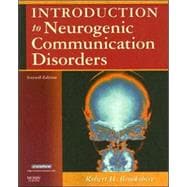
Note: Supplemental materials are not guaranteed with Rental or Used book purchases.
Purchase Benefits
What is included with this book?
| Neuroanatomy and Neuropathology | |
| Neurologic Assessment | |
| Assessing Adults Who Have Neurogenic Cognitive-Communicative Impairments | |
| Assessing Cognition | |
| Assessing Language | |
| Assessing Functional Communication and Quality of Life | |
| The Context for Treatment of Cognitive-Communicative Disorders | |
| Neuroanatomic Explanations of Aphasia and Related Disorders | |
| Treatment of Aphasia and Related Disorders | |
| Right Hemisphere Syndrome | |
| Traumatic Brain Injury | |
| Dementia | |
| Motor Speech Disorders | |
| Appendix | |
| Standard Medical Abbreviations | |
| Glossary | |
| ANSWERS TO THOUGHT QUESTIONS | |
| Bibliography | |
| Index | |
| Table of Contents provided by Publisher. All Rights Reserved. |
The New copy of this book will include any supplemental materials advertised. Please check the title of the book to determine if it should include any access cards, study guides, lab manuals, CDs, etc.
The Used, Rental and eBook copies of this book are not guaranteed to include any supplemental materials. Typically, only the book itself is included. This is true even if the title states it includes any access cards, study guides, lab manuals, CDs, etc.